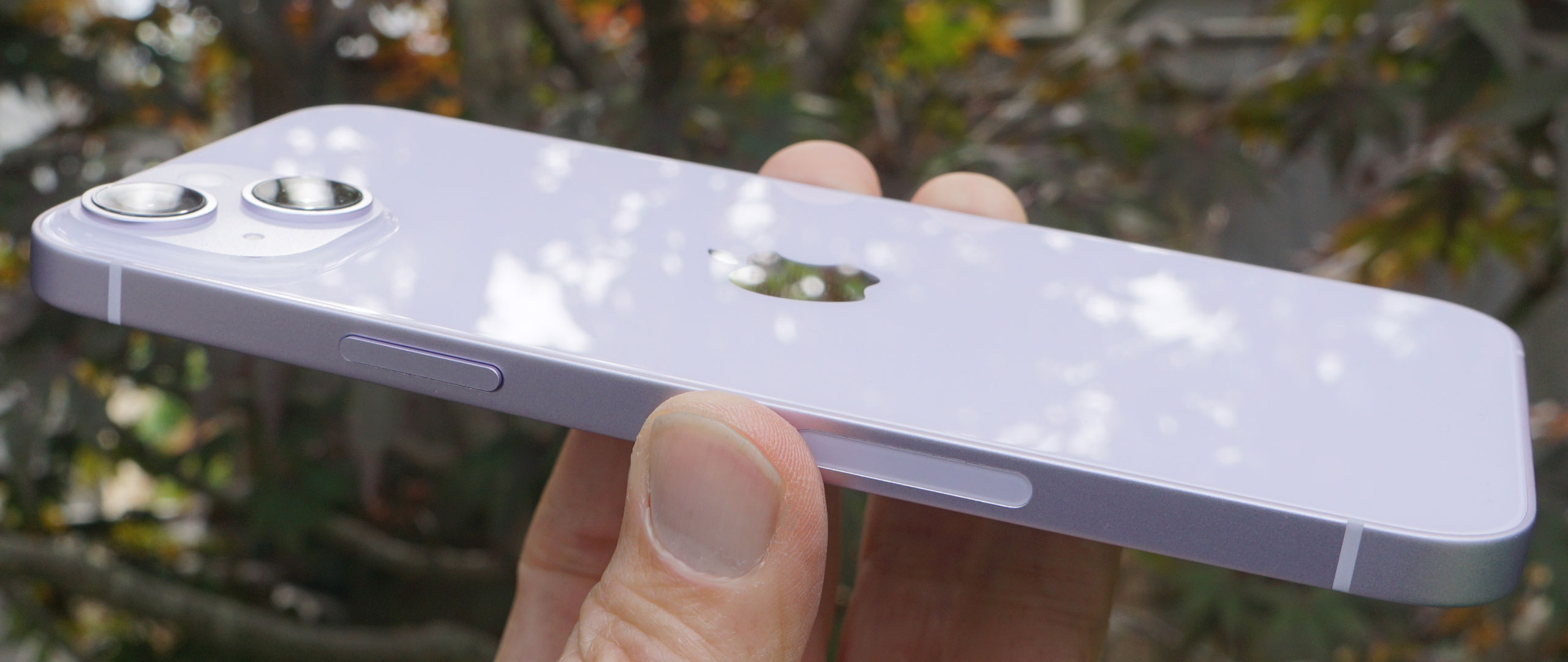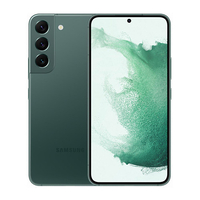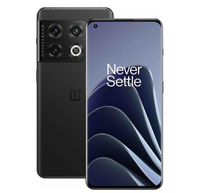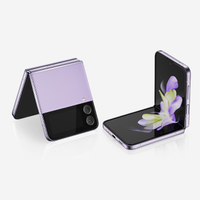TechRadar Verdict
The iPhone 14 Plus is a great option for those after a bigger handset, with a design, display, cameras and build quality that are all excellent, if a bit last-generation. It's also a more affordable way to get into Apple’s big-screen smartphone world, without having to shell out $1,000 / £1,000-plus.
Pros
- +
Attractive design, quality build
- +
Big screen and bigger battery
- +
eSIM (US models only) and satellite
- +
Good price for a big iPhone
Cons
- -
The notch is now very dated
- -
A15 Bionic isn't Apple's best chip
- -
Not a huge upgrade
Why you can trust TechRadar
Two-minute review
Everything you read about Apple’s iPhone 14 is true of the iPhone 14 Plus. You're getting the same processor, display technology, and dual camera array on the back. What sets this phone apart from its smaller sibling is, obviously, its screen size and battery life; and for some, that will be reason enough to choose it over the iPhone 14.
The 6.7-inch iPhone 14 Plus is a newcomer to the iPhone lineup, supplanting the adorably small iPhone 13 mini, which apparently failed to inspire buyers. With this more affordable plus-sized smartphone, Apple hopes to attract those who aspire to the big-screen excitement of the iPhone 14 Pro Max, but don’t have the budget to afford it; or who perhaps just don't need the power afforded by the iPhone 14 Pro Max’s 48MP sensor and leading-edge A16 Bionic CPU.
Coming with most of the same limitations as its non-Pro sibling, the iPhone 14 Plus might seem like just another good-enough handset; but don’t underestimate the benefits of a big screen and excellent battery life. These things matter, and getting them for $899 / £949 / AU$1,579 (for the base 128GB phone), as opposed to the $1,099 / £1,199 / AU$1,899 you’d pay for the iPhone 14 Pro Max, means this is a smartphone worth considering.
Taken by itself, the iPhone 14 Plus is a somewhat staid but attractive smartphone. The design is virtually unchanged from the iPhone 13 lineup, except for its Pro-level-without-being-Pro size. There's no Dynamic Island upgrade for the iPhone 14 or 14 Plus, with the notch that Apple made 20% smaller with the iPhone 13 sticking around for another generation. It’s still an excellent, 458ppi display with 2,000,000:1 contrast ratio; just note that there’s no always on-display or adaptive refresh rate here, and you'll be happy enough with the tasteful 60Hz OLED panel.
The best iPhone of this generation, sadly not, but it's still a brilliant option and offers a nice middle ground between the standard 14 and the 14 Pro Max, without the 14 Pro's price premium.
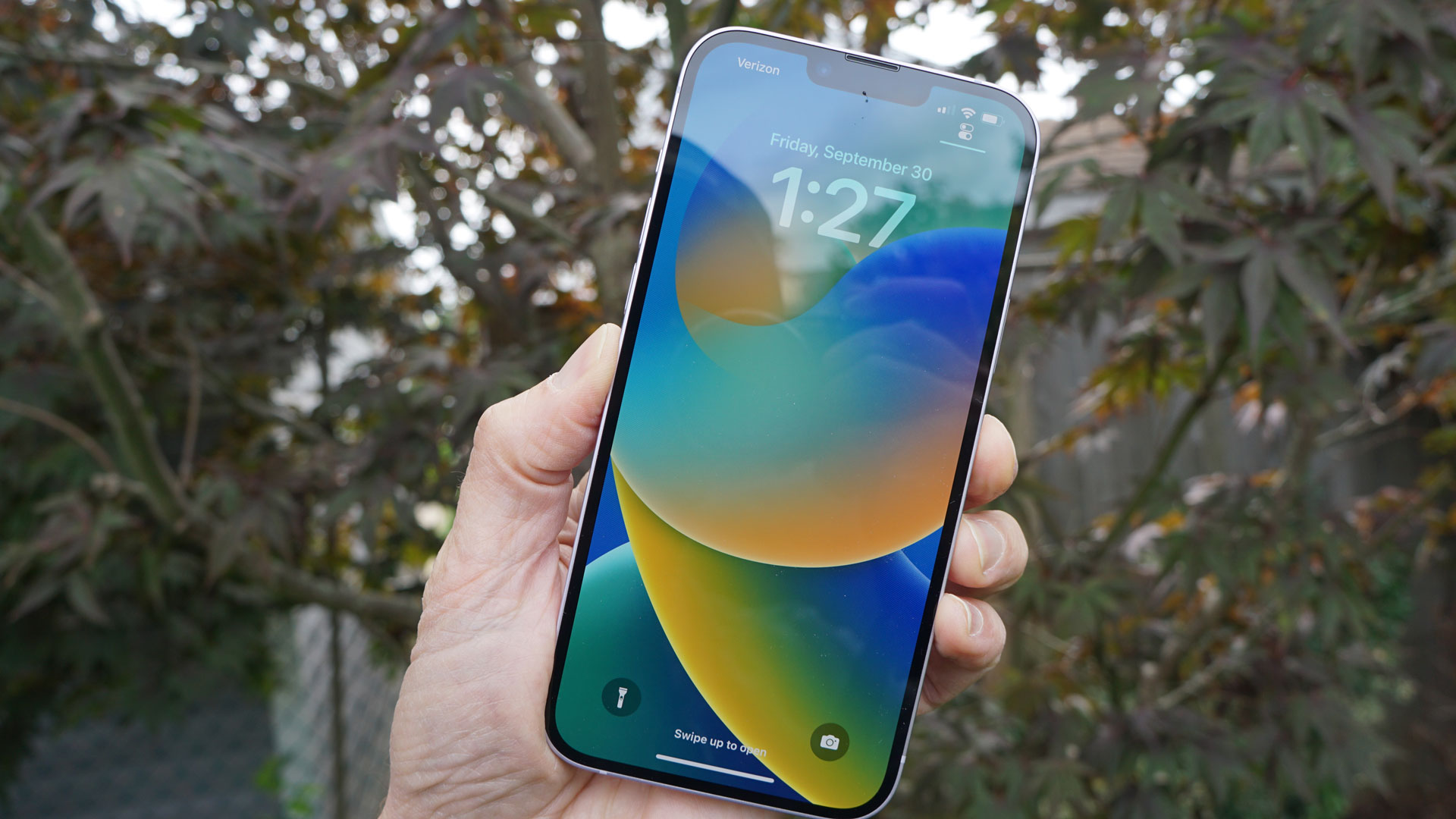
Even though we don't get a telephoto lens or a 48MP primary sensor on the iPhone 14 Plus, the two 12MP cameras on the back (the main and ultra-wide) are a step up from the iPhone 13’s array. Part of this is due to better sensors and lenses, but there’s also the new Photonic Engine, which applies Apple’s Deep Fusion image technology to uncompressed images. Even the front 12MP camera gets an upgrade, with a better sensor and autofocus.
These are characteristically above-average cameras that we think will satisfy most casual photographers and videographers.
Performance is excellent; in benchmarks the A15 Bionic (the same version of the chip as found in last year’s iPhone 13 Pro) is a tick below what you'd get from the iPhone 14 Pro series’ top-of-the-line A16 Bionic, but we challenge anyone to tell the difference in real-world use.
Battery life is, as you might expect with a phone of this size, exemplary. In one video rundown test we got a solid 25 hours, although your mileage, obviously, may vary.
While it can be difficult to avoid fixating on what the iPhone 14 Plus doesn't have, we think many will look at what the iPhone 14 Plus brings to the table: big-screen iPhone fun, performance, and battery life at a more affordable price than the equivalent Pro. And where the iPhone 14 offers no compelling reason to upgrade from the iPhone 13, the appeal of the iPhone 14 Plus is visibly obvious.
iPhone 14 Plus price and availability
- 128GB: $899 / £949 / AU$1,579
- 256GB: $999 / £1,059 / AU$1,749
- 512GB: $1,199 / £1,279 / AU$2,099
Apple unveiled its entire iPhone 14 line – the iPhone 14, iPhone 14 Plus, iPhone 14 Pro, and iPhone 14 Pro Max – on September 7, 2022.
The iPhone 14 Plus went on preorder on September 9 and is now available, as of October 7. It starts at $899 / £949 / AU$1,579 for the 128GB model, but you can get it with up to 512GB of storage (check out our best iPhone 14 deals if you're already interested).
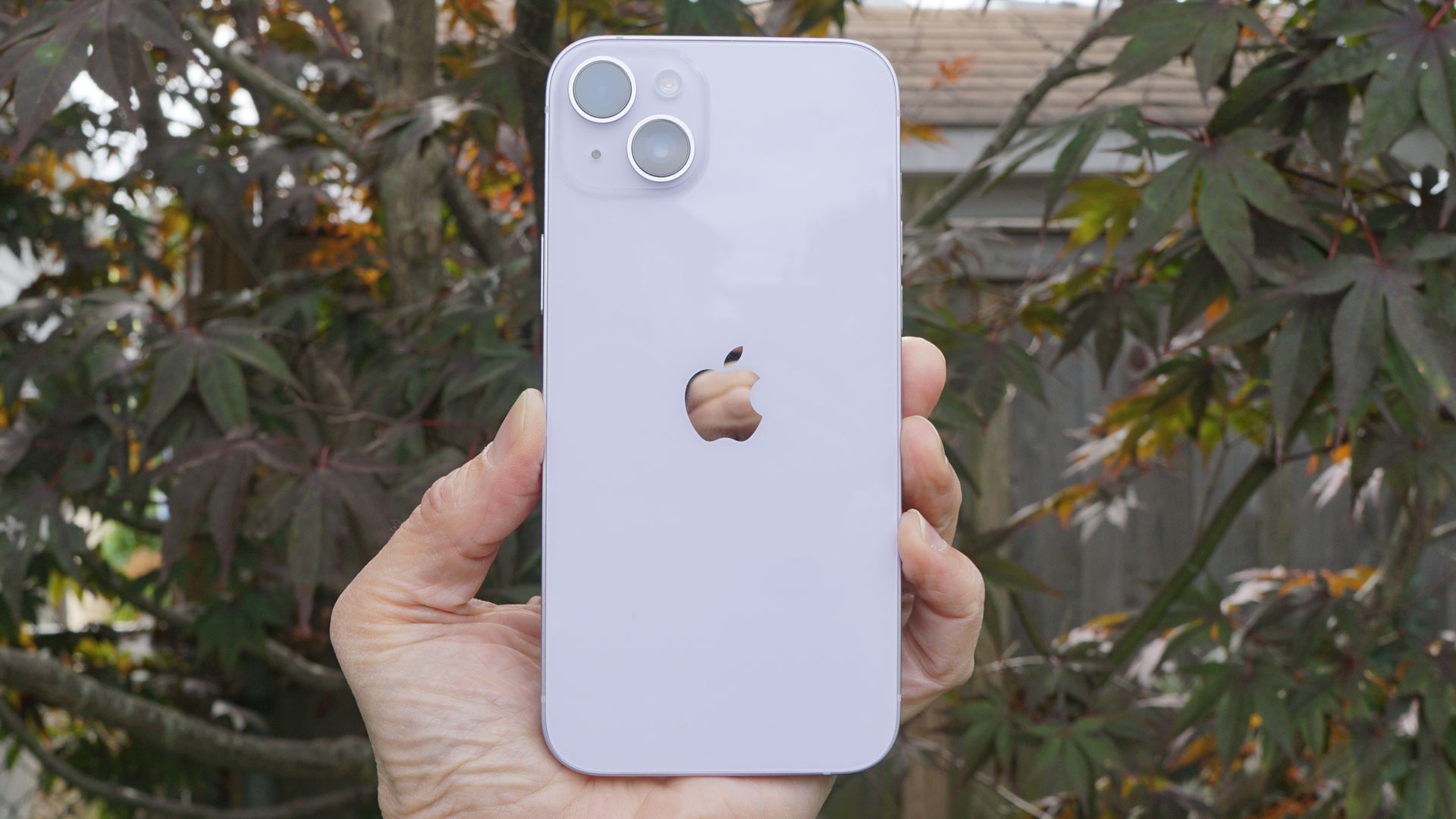
- Value score: 4/5
iPhone 14 Plus specs
The iPhone 14 Plus comes in three storage configurations – 128GB, 256GB and 512GB – with 6GB of RAM offered across the board.
| Header Cell - Column 1 | |
|---|---|
| Dimensions: | 78.1 x 160.8 x 7.8mm |
| Weight: | 203g |
| Screen: | 6.7-inch Super XDR OLED |
| Resolution: | 2778 x 1284 pixels |
| Refresh rate | 60Hz |
| CPU: | A15 Bionic |
| RAM: | 6GB |
| Storage: | 128GB / 256GB / 512GB |
| OS: | iOS 16 |
| Rear Cameras: | 12MP main (26mm, f/1.5), 12MP ultrawide (13mm, f/2.4) |
| Front Camera: | 12MP |
| Battery: | 3,279mAh |
| Charging: | 20W (wired) + MagSafe & wireless |
| Colors: | Midnight, Starlight, red, blue, purple, yellow |
iPhone 14 Plus design
- Aging design, but one that retains its allure
- Solid aluminum construction
- Glass and Ceramic Shield have premium looks
- No SIM slot on US models
From its aluminum frame to its glass back, its edge-to-edge, ceramic-shield-covered and notched display, its pill-shaped volume and power buttons, alert slider, Lightning port and grille placement, the design of the iPhone 14 Plus is eminently familiar, and mostly – we emphasize mostly – unchanged from the iPhone 12 and iPhone 13 before it.
Naturally, there's an undeniable size difference. Whereas the 6.1-inch iPhone 14 is virtually indistinguishable from the iPhone 13, the 6.7-inch iPhone 14 Plus is 6.33 inches (160.8mm) tall and 3.07 inches (78.1mm) wide. Compare this to the 5.78-inch (146.7mm) by 2.82-inch (71.5mm) iPhone 14. The two phones are, by the way, the exact same thickness, at 0.31-inches (7.8mm).
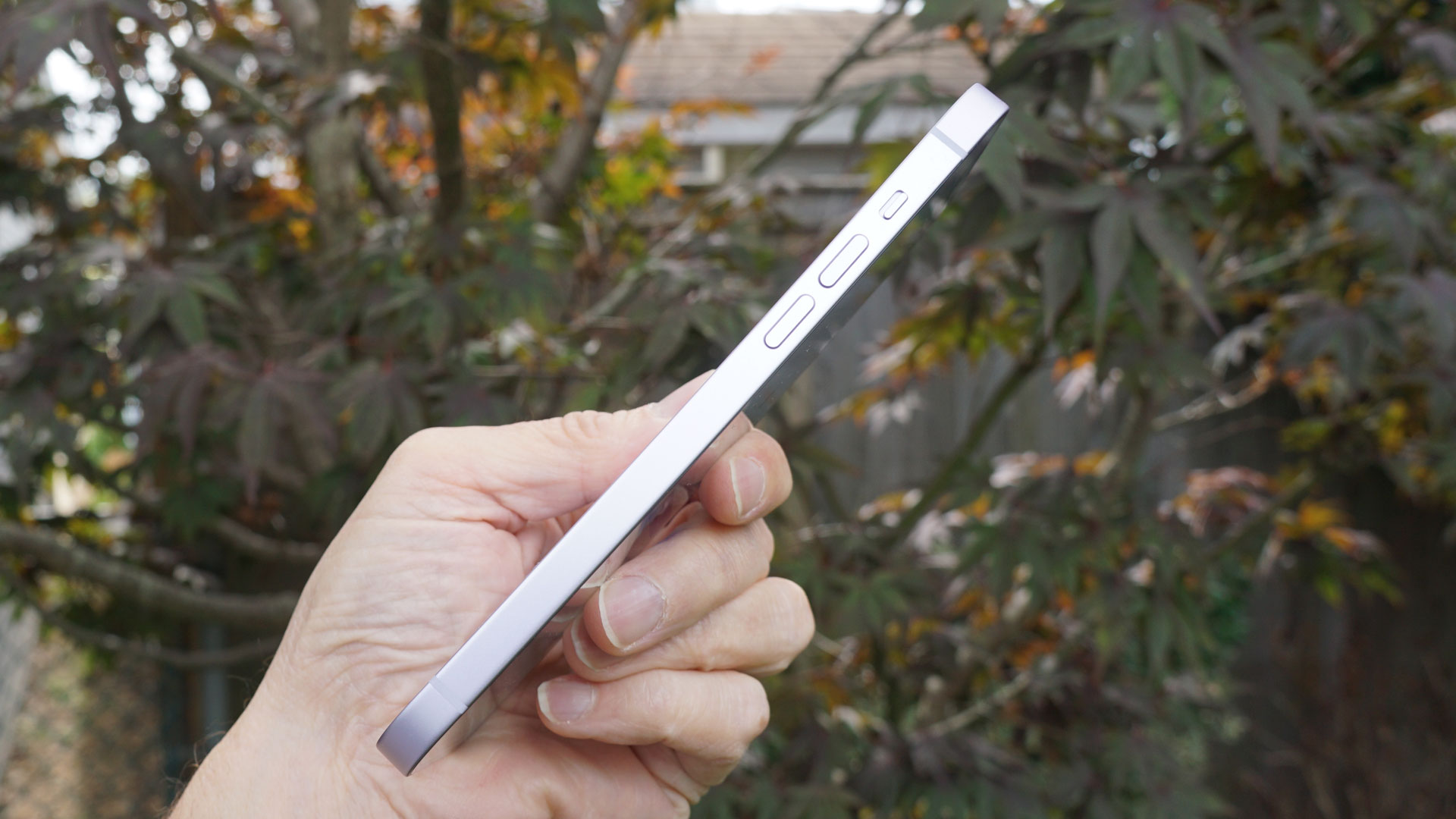
Without question, the biggest design difference from the iPhone 13 generation to the iPhone 14 line of phones – although only on models sold in the US – is that there’s no SIM slot along the left edge. The switch to an all eSIM design in the US has made the physical SIM slot obsolete, and gives the phone a slightly cleaner look.
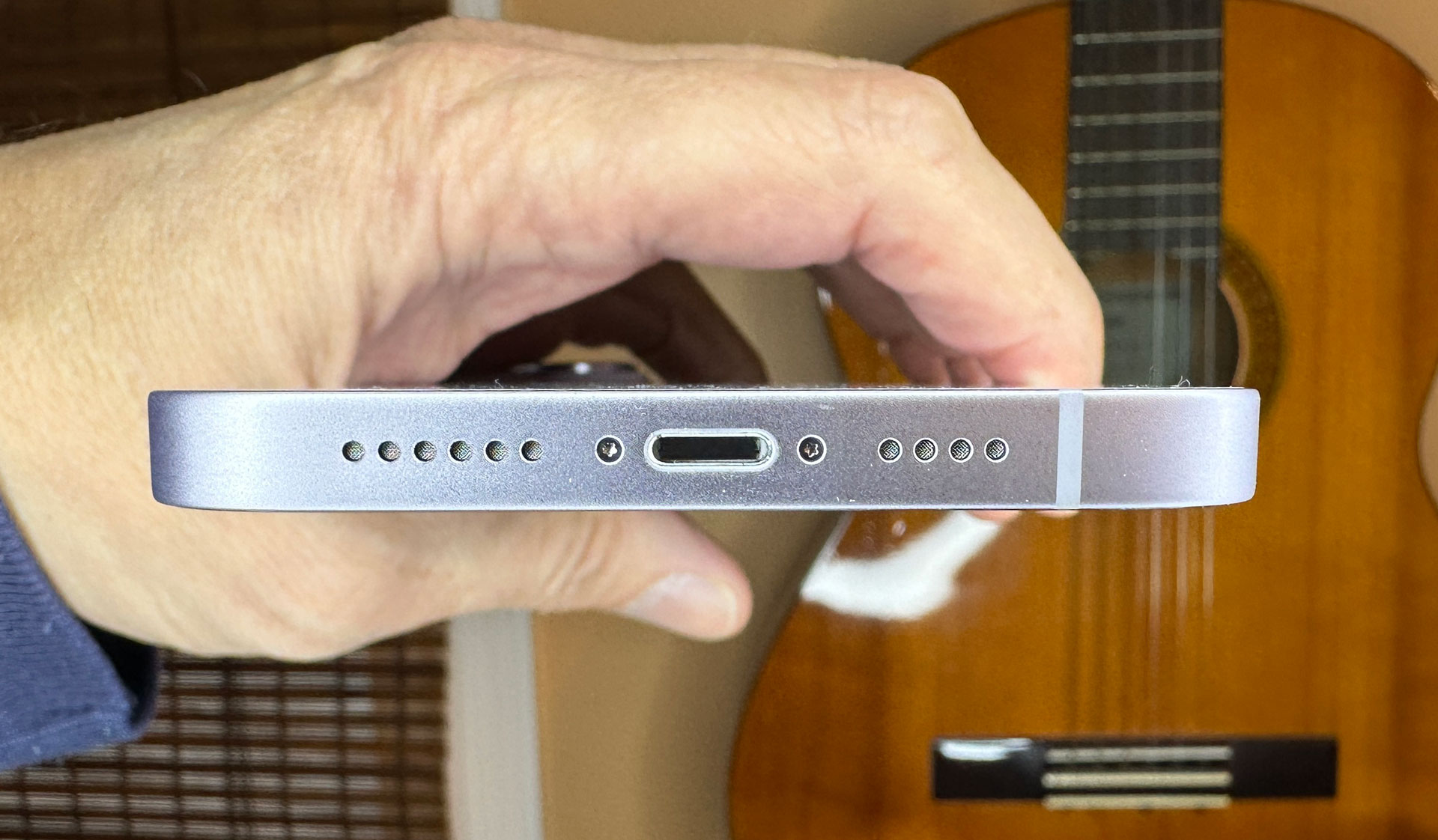
This larger iPhone does outweigh the iPhone 14, coming in at 203 grams to the iPhone 14’s 172 grams, although despite being essentially the same size as the iPhone 14 Pro Max, the iPhone 14 Plus is 37 grams lighter. This may be due to the Plus' new thermal management system, which helps keep the phone operating cooler and – according to Apple – makes it easier to replace a broken back glass panel.
In general, the handset feels cool, smooth, and solid. We didn’t drop it to test durability, but we did run the phone under some cool water. It can handle that, and is rated for up to 1.5 meters of freshwater for 30 minutes – just don’t plug it back in until it's fully dried out.
Design score: 4/5
iPhone 14 Plus display
- Super Retina XDR OLED is still the best iPhone screen technology you can get
- You might miss adaptive refresh
- Bigger is better in videos, photography, gaming, and more
- Sorry, no always-on display
- It’s time to retire the notch
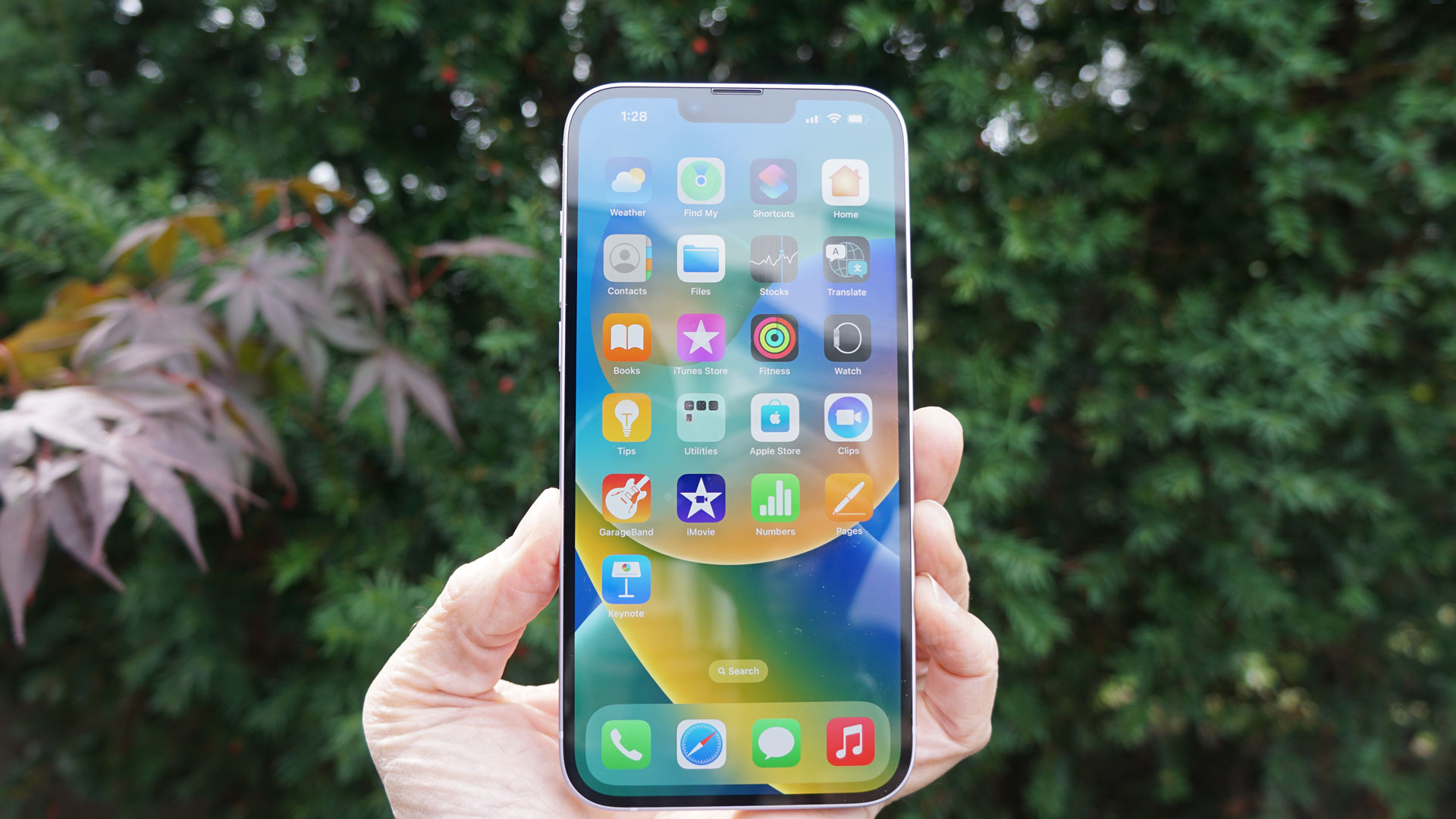
Apple gave the iPhone 14 Plus its best OLED display – the Super Retina XDR – but still with the limitation of the notch. This means Apple’s newest model remains saddled with a feature the company will surely phase out in a generation or two.
If we’d never seen the iPhone 14 Pro and Pro Max’s adaptable Dynamic Island, we probably wouldn’t mind, but the notch now feels excessive and overbearing by comparison. At least it appears smaller on the iPhone 14 Plus’s large 2278 x 1284 display – there are more pixels on this display than on the iPhone 14's, but the pixels per inch is actually a hair lower (458ppi vs 460).
None of this is to say the HDR, wide-color, True Tone-supporting display isn’t gorgeous. It is. Everything from games to photos, videos and TikToks looks great on it. Its 2,000,000:1 contrast ensures that blacks look inky, and everything else pops.
Even without an adaptive refresh rate, and despite the fact that the panel on the 14 Plus is stuck at 60Hz, it still feels responsive. Gameplay in PUBG and Asphalt 9: Legends looked smooth enough to the naked eye. If, though, you like the sound of Apple’s new always-on display, think about the iPhone 14 Pro or 14 Pro Max instead.
Of course, the other big benefit of the iPhone 14 Plus is that the screen is noticeably bigger than that of the iPhone 14, which means, to our eyes, an even better video and gaming experience. Obviously, you're not getting more pixels, but the extra millimeters of visual real estate make everything bigger. Plus, you have some nice little Plus-sized display benefits, like the ability to hold the device in landscape mode, open Mail and see your account's assorted folders in the left-hand column. These folders aren't persistent, but it’s still a nice perk that’s exclusive to the larger models in the iPhone 14 series.
As far as screen protection goes, the iPhone 14 Plus has the same Ceramic Shield as the rest of the iPhone 14 line – so might be worth watching this iPhone 14 Pro Max drop test to see what sort of punishment the material can take.
- Display score: 3.5/5
iPhone 14 Plus cameras
- A good set of iPhone 13 Pro transplants
- Bigger sensor and Photonic Engine take image quality up a notch
- One bigger sensor would’ve been nice
- Action mode
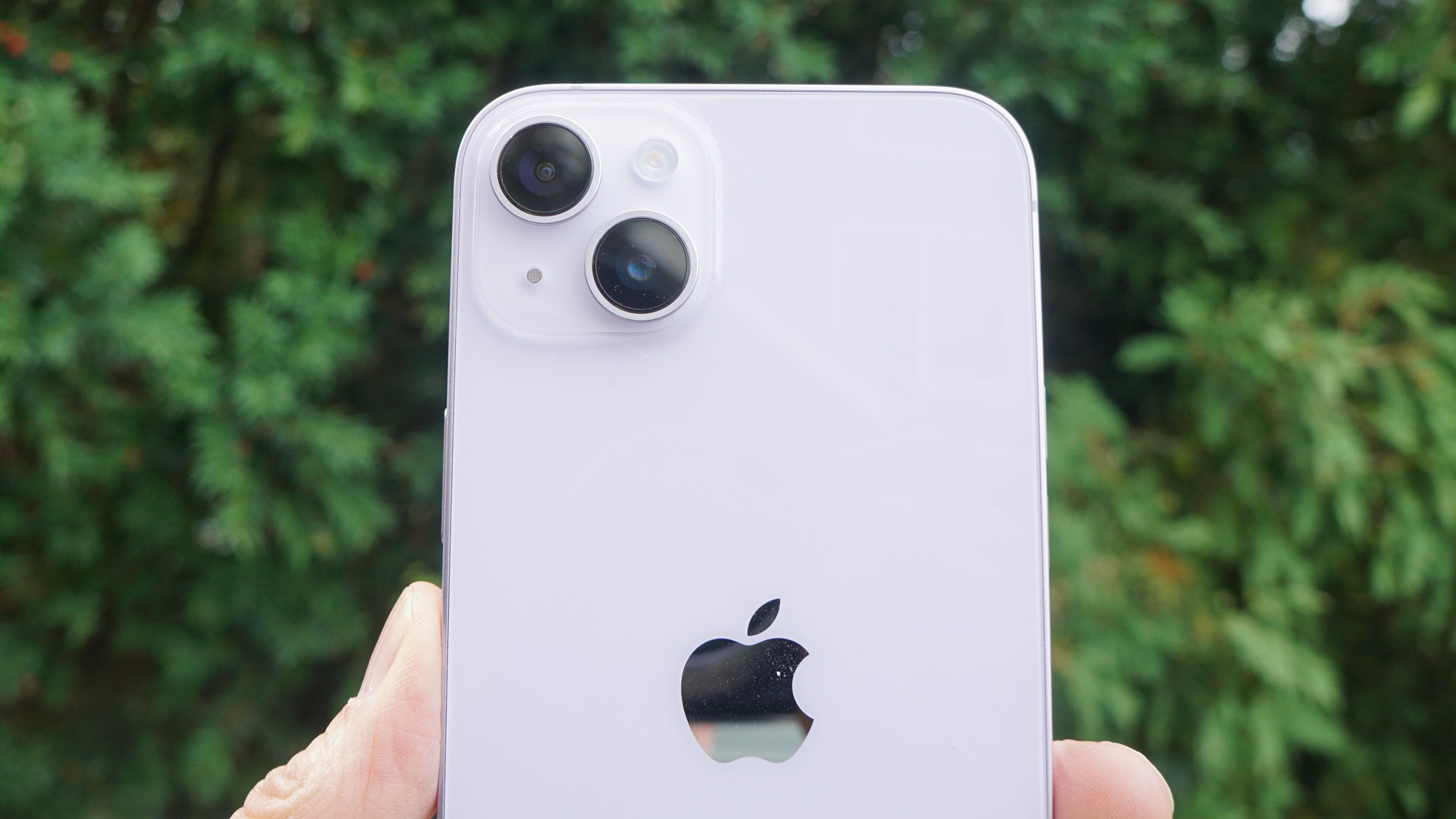
Apple has upgraded the camera system on the iPhone 14, and has put the exact same setup on the iPhone 14 Plus. It’s still two 12MP cameras on the back: a 26mm, f/1.5 lens and a 13mm, f/2.4 ultrawide with a 120-degree field of view.
Apple has not only upgraded the lenses, but is backing them with a larger sensor sporting larger pixels, for better low-light performance. All the cameras, including the new 12MP front-facing camera, are also supported by Apple’s new Photonic Engine, which, among other things, applies the company’s Deep Fusion image processing to uncompressed images, earlier in the image processing pipeline than before. This also results in better low-light performance, and more visual detail.
If your eyes glazed over during that description, then just know that photo quality is noticeably better when compared to iPhone 13’s cameras. It’s not a huge change, but we really could see it in every single image. Better color, clarity, and detail… there's more truth in the images. The impact is especially noticeable in ultrawide photos, which offer more color information across the entire frame.
Portrait mode photography continues to improve on both the front and back, and is particularly impressive in low-light situations.
For video, the cameras are all still capable of shooting up to 4K 60fps video. The marquee feature is the new Action Mode that's available for the rear cameras, which uses software and AI to smooth out the shaky video. It essentially acts like a digital gimbal, as you’d find on a GoPro. We took a run with an iPhone 14 and the iPhone 14 Plus, enabling Action Mode on the Plus (but leaving it off on the 14). As you’d hope, video turned out smoother, however, despite being a cool feature it’ll likely be of limited utility for most people.
- Camera score: 3.5/5
iPhone 14 Plus three cameras
- A 12MP main (26mm, f/1.5)
- A 12MP ultrawide (120-degree field of view, 13mm, f/2.4)
- Front-facing camera: 12MP f/1.9
Camera samples




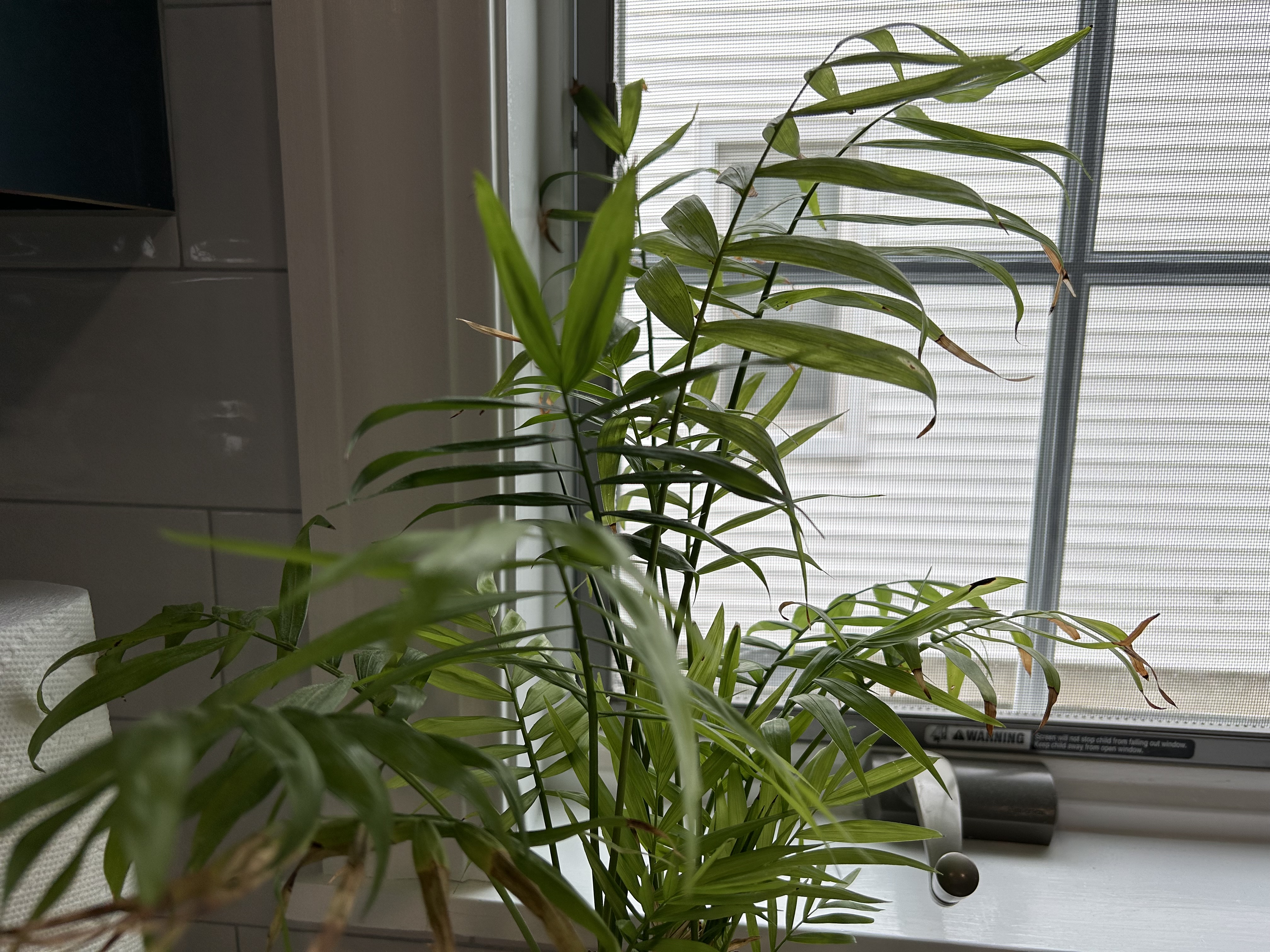


iPhone 14 Plus audio
While it's likely that you’ll use the iPhone 14 Plus with Bluetooth earbuds or headphones, the phone’s stereo speakers can get plenty loud on their own – at one point we measured 79 decibels. And it’s not just ear-piercing audio: Apple Music sounds excellent, as well. Having tested the speakers with a little Barbra Streisand, they sound just as good, if not better than, any decent Bluetooth speaker.
iPhone 14 Plus performance
- A15 Bionic (iPhone 13 Pro class) is still a winner
- Still hard to find the performance limits
- New internal design might be helping with performance
The iPhone 14 and iPhone 14 Plus are powered by last year’s Apple silicon; however, while that might sound less than optimal, the reality is that the A15 Bionic is an excellent mobile chipset. Also, Apple didn't try to saddle this phone with the same processor it put in the iPhone 13; instead, this is the chip it placed in the iPhone 13 Pro and 13 Pro Max, which is notable for its extra GPU core.

The phone's Geekbench 5 benchmark numbers came in about where we expected: better than the iPhone 13, but somewhat lower than the A16 Bionic in the iPhone 14 Pro.
For all practical purposes, you probably won’t notice the difference, though. This is a fast phone, with enough headroom to play demanding high-fidelity games, shoot 4K video, and edit four 4K streams in Adobe Premiere Rush CC, all at once.
- Performance score: 4/5
iPhone 14 Plus eSIM and Emergency SOS
In the US, Apple is doing away with SIM slots and making eSIM the standard. This may come as a shock for people who like the comfort of that tiny piece of communication hardware, but we've found that switching eSIMs to new phones like the iPhone 14 Plus is incredibly easy – so much so that we switched an existing phone number from, first, a physical-SIM-supported iPhone to an eSIM iPhone 14 Pro, and then did a separate switch of an eSIM number on the iPhone 14 to the iPhone 14 Plus. As long as you follow all the on-screen instructions, it’s absolutely painless.
Outside the US, you'll still have your SIM slot and SIM cards (as well as eSIM support), though we think you should prepare for this inevitable change.
You'll hopefully never have to make use of Apple’s new Emergency SOS satellite connectivity, but the ability to reach emergency services when all traditional communications fail could also save your life. While we didn’t test it on our review phone, Apple did show us how it worked shortly after the iPhone 14 line launched, in September.
They took us up a hill at Apple Park – a space where they could switch off Wi-Fi and cellular access. While there, the iPhone 14 displayed a cute little satellite icon in the upper right-hand corner of the screen; an indication that emergency satellite services were available from our location.
Dialing 911 in this situation, the iPhone 14 should – as it did in our demo – launch a new dialogue pop-up asking if you want to try emergency text via satellite. After that, an on-screen emergency assistant offers a visual cue for which way you should face to connect to the nearest satellite. It then asks you a series of questions that the system can deliver via compressed text to an Apple relay center, which then contacts emergency services.
If, during the communication, a satellite moves out of range, the system will prompt you to face in the right direction to reconnect.
As a further safety measure, the phone now includes Crash Detection, another feature we could not (really would not) test. The idea is simple, though. If you're in a car crash and your iPhone 14 Plus is with you, it can detect the crash (yes, and tell the difference between a bump and something quite serious). In that event, the phone can automatically contact emergency services and even your emergency contact, provided you put it in your phone.
Along with the rest of the iPhone 14 lineup, this is a 5G phone that also supports WiFi 6. Its connectivity is good, and speeds can be great when you have a solid network connection.
The best 5G speeds, though, were only possible in some parts of our hometown and New York City. In other words, your speeds will be largely dependent on where you live, and how well built-out the 5G network is in your area.
iPhone 14 Plus battery
- Breaks the full-day battery life barrier
- Seems to sip power
- Fast charging could be… faster
Aside from the bigger screen, the main reason you might choose an iPhone 14 Plus over the 14 is battery life. For those who prize that feature over others, you’ll really want to take a look at the iPhone 14 Plus.
We did a video rundown test with both the iPhone 14 and iPhone 14 Plus, playing a mostly steady stream of Netflix. The iPhone 14 lasted nearly 20 hours, and the iPhone 14 Plus served us approximately 25 hours of playback.
Different activities will alter those battery life numbers, but, at least in this scenario, the iPhone 14 Plus proves it can offer impressive longevity.
Apple’s version of middling fast charging is still there. We used a 20W Apple charger to charge the phone to 45% in 30 minutes. After one hour and 10 minutes, it was at 90%.
The iPhone 14 Plus supports MagSafe for iPhone and Qi wireless charging. It does ship with a USB-C-to-Lightning plug cable, but no power adapter.
- Battery score: 4.5/5
iPhone 14 Plus software
- iOS 16 experience is exemplary
- Better experience in Messages, email and Maps
- Lock screen will change how you use the iPhone
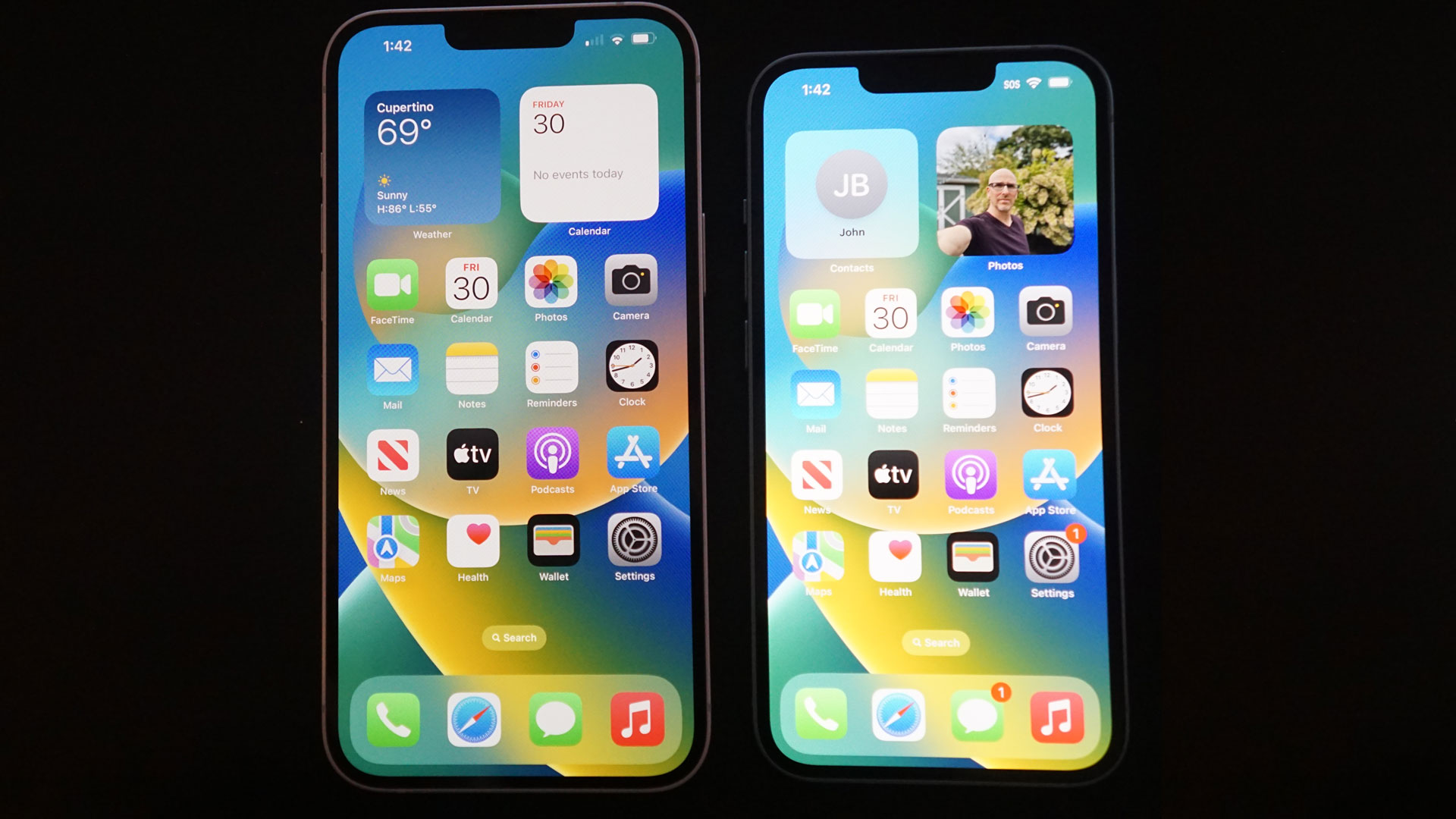
All iPhone 14 phones come with iOS 16 pre-installed. Key updates include the new lock screen, which includes image segmentation, so that, for example, the head of your subject can partially cover the redesigned clock.
There are editable and retrievable messages – a feature we’ve started to use with more frequency. There’s ‘schedule’ (send later) and ‘unsend email’, as well.
In addition, you'll find updated maps with multi-point directions, and image segmentation that allows you to select an image subject from virtually any photo and then drag and drop it into another app; it’s incredibly cool.
- Software score: 4.5/5
In some ways, we like the iPhone 14 Plus as much as we liked the iPhone 14. It’s an excellent handset with an above-average design and features. That said, it's also not a lot different to the iPhone 13, and we can’t help but wish all iPhone 14 handsets, especially this big-screened newbie, had the Dynamic Island.
Where the iPhone 14 Plus sets itself apart, though, is it's size, battery life, and value. Getting a bigger screen and all that battery life is worth another $100 / £100 in our eyes.
iPhone 14 Plus score card
| Attributes | Notes | Rating |
|---|---|---|
| Design | Good-looking quality build and design | 4/5 |
| Display | Super Retina XDR OLED is still the best iPhone screen technology you can get but, oh, the notch | 3.5/5 |
| Performance | A15 Bionic (iPhone 13 Pro class) is still a winner | 4/5 |
| Camera | A good set of iPhone 13 Pro transplants | 3.5/5 |
| Battery | This phone breaks the full-day battery life barrier | 4.5/5 |
| Software | iOS 16 experience is exemplary | 4.5/5 |
| Value | A big iPhone with a non-Pro price | 4/5 |
Should I buy the Apple iPhone 14 Plus?
Buy it if...
You really want a big-screen iPhone
The introduction of the iPhone 14 Plus means Apple fans now have two big-screen iPhone options, and this may be one they can afford.
You need more battery life
We know, you’re tired of running out of battery life at the least opportune time. The big iPhone 14 Plus hook is that it offers more than a full day of battery life.
You still love the notch
How this is possible after seeing Appel's Dynamic Island, we do not know. Still, that TrueDepth Module remains quite powerful and useful, and it houses an improved front-facing camera. And you get all this for less than you'd pay for a phone with a Dynamic Island.
You want an affordable way into satellite SOS
This neat ability to talk to satellites and help get you out of a jam is unique among leading smartphones.
Don't buy it if...
You’re over the notch
There’s no getting around the True-Depth Module notch, even if it does appear smaller on this big-screened phone.
You’re a photographer
The iPhone 14 Plus has a trio of good cameras, but the better set, and the big 48MP sensor, can only be found on the 14 Pro models.
Also consider
Samsung Galaxy S22
The Samsung Galaxy S22 is small, fast, and offers a clean and reliable Android experience. It's an incremental update that keeps what was good in the S21, and upgrades the camera, processor, and materials to create a solid Android device.
Read our Samsung Galaxy S22 review for more
OnePlus 10 Pro
The OnePlus 10 Pro is a great premium all-around phone with a good-looking screen, fast charging and powerful internals. The cherry on the cake is that it costs less than other 'Pro' phones, making it an incredibly tempting choice. However, its Achilles’ heel is the camera experience – there are a few problems with both the hardware and software that might put off passionate photographers.
Read our OnePlus 10 Pro review for more
Samsung Galaxy Z Flip 4
Samsung has addressed some of the Z Flip 3's biggest pain points with its 2022 successor – mainly by way of a larger battery that fits into a more compact form factor – but there's still plenty of room left for improvement. Price versus performance remains unmatched in the market, especially when you consider that this is one of the only water-resistant foldables out there.
Read our Samsung Galaxy Z Fold 4 review for more
First reviewed: October 2022

A 38-year industry veteran and award-winning journalist, Lance has covered technology since PCs were the size of suitcases and “on line” meant “waiting.” He’s a former Lifewire Editor-in-Chief, Mashable Editor-in-Chief, and, before that, Editor in Chief of PCMag.com and Senior Vice President of Content for Ziff Davis, Inc. He also wrote a popular, weekly tech column for Medium called The Upgrade.
Lance Ulanoff makes frequent appearances on national, international, and local news programs including Live with Kelly and Mark, the Today Show, Good Morning America, CNBC, CNN, and the BBC.
